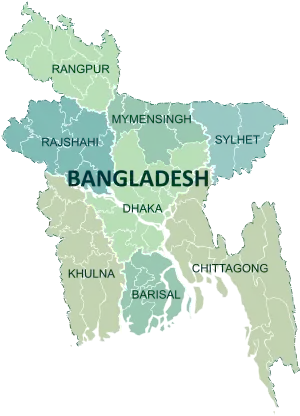Khulna District
The Khulna District (Bengali: খুলনা জেলা, Khulna Jela also Khulna Zila) is a district of Bangladesh. It is located in the Khulna Division, bordered on the north by the Jessore District and the Narail District, on the south by the Bay of Bengal, on the east by the Bagerhat District, and on the west by the Satkhira District.[3] It was the very first sub-division of United Bengal Province established in 1842 under Jessore district. On 1 June 1882, by notification of the official gazette published from Kolkata, Khulna and Bagerhat sub-division of Jessore district and Satkhira sub-division of 24 Pargana district formed the new Zila 'Khulna'.
Khulna district
খুলনা জেলা | |
|---|---|
.jpg.webp)     Clockwise from top-left: House of Rabindranath Tagore's father-in-law, Bamboo transported on the Poshur, Ten Dome Mosque, Rupsa Bridge, View of fields near Chalna | |
 Location of Khulna District in Bangladesh | |
Expandable map of Khulna District | |
| Coordinates: 22.35°N 89.30°E | |
| Country | |
| Division | Khulna Division |
| Seat | District council, Khulna |
| Government | |
| • Deputy Commissioner | Mohammad Helal Hossain, PAA |
| Area | |
| • Total | 4,389.11 km2 (1,694.64 sq mi) |
| Population (2022 census)[1] | |
| • Total | 2,613,385 |
| • Density | 600/km2 (1,500/sq mi) |
| Time zone | UTC+06:00 (BST) |
| Postal code | 9000 |
| HDI (2019) | 0.690[2] medium · 3rd of 20 |
| Website | www |
Geography and climate
Khulna District has a total area of 4,389.11 square kilometres (1,694.64 sq mi).[4] It borders Jessore District to the north, Narail District to the northeast, Bagerhat District to the east, the Bay of Bengal to the south, and Satkhira District to the west.[3]
Major rivers of Khulna District are the Rupsa (a continuation of the Bhairab and Atrai), Arpangachhia, Shibsa, Pasur, and the Koyra.[3]
Demographics
| Year | Pop. | ±% p.a. |
|---|---|---|
| 1974 | 1,386,347 | — |
| 1981 | 1,771,101 | +3.56% |
| 1991 | 2,010,643 | +1.28% |
| 2001 | 2,378,971 | +1.70% |
| 2011 | 2,318,527 | −0.26% |
| 2022 | 2,613,365 | +1.09% |
| Sources:[1][5] | ||
According to the 2022 Census of Bangladesh, Khulna District had 670,923 households and a population of 2,613,365, 40.8% of whom lived in urban areas. The population density was 595 people per km2. The literacy rate (age 7 and over) was 80.6%, compared to the national average of 74.7%.[1]
76.63% of the population was Muslim and 22.68% Hindu at the time of the 2011 census. There was a small minority of Christians as well which was 0.66% of the population.[5]
| Religion | Population (1941)[6]: 86–87 | Percentage (1941) | Population (2011)[5] | Percentage (2011) |
|---|---|---|---|---|
| Hinduism |
366,867 | 58.29% | 525,727 | 22.68% |
| Islam |
260,869 | 41.45% | 1,776,749 | 76.63% |
| Christianity | 786 | 0.12% | 15,239 | 0.66% |
| Others [lower-alpha 2] | 896 | 0.14% | 812 | 0.03% |
| Total Population | 629,418 | 100% | 2,318,527 | 100% |
Khulna was a Hindu-majority part of Bangladesh before Partition, but during the massive riots in the 1950s and 60s most of the Hindus there fled to India. The population of Hindus and Christians has remained constant since 1981, but their absolute numbers have fallen massively.
Education
The district contains educational institutions including:
- School
- Government Coronation Secondary Girls' School
- Government Daulatpur Muhsin High School
- Khulna Zilla School
Colleges
- Govt Majid Memorial City College
- Khulna Government Model School and Collage
- Khulna Medical College
- Khulna Dental College
- Khulna Collectorate Public School and College
Universities
See also
Notes
- Sadar subdivision of Khulna district, excluding territory in Sundarbans Forest thana (which is less than 7000 people for the entire district)
- Including Jainism, Buddhism, Zoroastrianism, Judaism, Ad-Dharmis, or not stated
References
- Population and Housing Census 2022: Preliminary Report. Bangladesh Bureau of Statistics. August 2022. pp. viii, 27, 29, 38, 43, 46. ISBN 978-984-35-2977-0.
- "Sub-national HDI - Area Database". Global Data Lab. Retrieved 18 March 2020.
- Sandipak Mallik (2012). "Khulna District". In Sirajul Islam and Ahmed A. Jamal (ed.). Banglapedia: National Encyclopedia of Bangladesh (Second ed.). Asiatic Society of Bangladesh.
- "District Statistics 2011: Khulna" (PDF). Bangladesh Bureau of Statistics. Retrieved 29 October 2017.
- "Bangladesh Population and Housing Census 2011 Zila Report – Khulna" (PDF). bbs.gov.bd. Bangladesh Bureau of Statistics.
- "Census of India, 1941 Volume VI Bengal Province" (PDF). Retrieved 13 August 2022.
